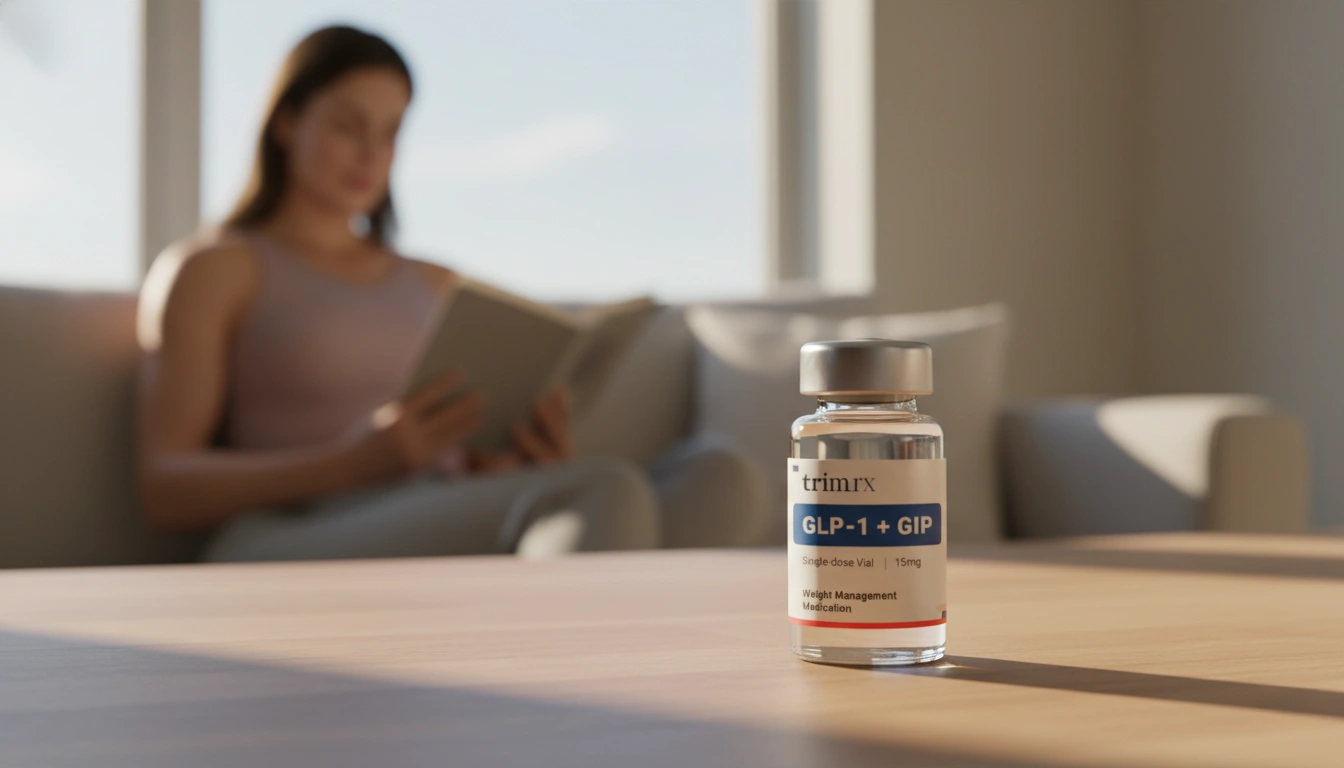Why Do GLP-1 Medications Cause Nausea?

Nausea is one of the most frequently reported side effects for individuals taking glucagon-like peptide-1 (GLP-1) medications, a class of drugs increasingly recognized for their effectiveness in weight management and diabetes control. Have you ever wondered why this unsettling sensation is so common with these medications? Understanding the mechanisms behind this side effect not only sheds light on the medications themselves but also offers insights into how we can better manage our experiences with them.
In this blog post, we will explore the underlying reasons why GLP-1 medications cause nausea, the factors that influence the severity of this side effect, and effective strategies to mitigate it. As a leading provider of personalized weight loss solutions, we at TrimRx are committed to helping you navigate the complexities of weight management and medication use.
Together, we’ll delve into the science behind GLP-1 medications, their effects on the gastrointestinal system, and practical tips to help you maintain your health and well-being throughout your weight loss journey. By the end of this post, you will have a comprehensive understanding of why GLP-1 medications can lead to nausea and how you can manage this side effect effectively.
Introduction
The rise in obesity rates has prompted a greater focus on effective treatment options, leading to the increased use of GLP-1 medications like Semaglutide and Tirzepatide. These medications mimic the action of the GLP-1 hormone, which plays a crucial role in regulating appetite and insulin secretion. However, as effective as they are, many individuals experience nausea when beginning treatment or adjusting doses.
Historically, GLP-1 medications were primarily prescribed for type 2 diabetes management. Still, their appetite-suppressing effects have made them popular for weight loss as well. While clinical trials have shown promising results for weight management, the side effects—particularly gastrointestinal disturbances—have raised questions about patient adherence to treatment protocols.
In this post, we aim to clarify the mechanisms that result in nausea when using GLP-1 medications and outline actionable strategies to alleviate this common issue.
Understanding GLP-1 Medications
What Are GLP-1 Medications?
GLP-1 medications are a class of drugs known as GLP-1 receptor agonists. They are primarily used to manage type 2 diabetes and assist with weight loss in individuals with obesity. These medications work by mimicking the GLP-1 hormone, which is naturally secreted in the gut in response to food intake.
When we consume food, GLP-1 enhances insulin secretion from the pancreas, suppresses glucagon release (a hormone that raises blood sugar levels), and slows gastric emptying. This combination of actions leads to lower blood sugar levels and reduced appetite, making GLP-1 medications effective for weight management.
How Do GLP-1 Medications Work?
-
Stimulating Insulin Secretion: GLP-1 medications promote insulin release in a glucose-dependent manner, which means insulin is only released when blood glucose levels are high, reducing the risk of hypoglycemia.
-
Suppressing Glucagon: Glucagon is another hormone that raises blood sugar levels. By suppressing glucagon, GLP-1 medications further help in stabilizing blood sugar levels.
-
Slowing Gastric Emptying: One of the most significant effects of GLP-1 medications is the slowing of gastric emptying. This means that food stays in the stomach longer, which can enhance feelings of fullness but also contribute to nausea.
-
Reducing Appetite: GLP-1 medications act on the brain’s appetite centers to reduce hunger and food intake.
Common GLP-1 Medications
Several GLP-1 medications are available, including:
- Semaglutide (Ozempic, Wegovy)
- Tirzepatide (Mounjaro, Zepbound)
- Liraglutide (Victoza, Saxenda)
Each of these medications has distinct indications, dosages, and potential side effects, but nausea remains a common concern across the board.
The Mechanisms Behind Nausea
Why Do GLP-1 Medications Cause Nausea?
Nausea is primarily linked to the effects of GLP-1 medications on the gastrointestinal system. Here are the key mechanisms involved:
-
Delayed Gastric Emptying: As mentioned earlier, one of the primary actions of GLP-1 medications is to slow gastric emptying. While this can help maintain satiety, it can also lead to an uncomfortable feeling of fullness or bloating, which may manifest as nausea.
-
Impact on Gut Hormones: GLP-1 medications influence various gut hormones, which can alter normal gastrointestinal motility and function. The resultant changes in gut activity can lead to nausea and other gastrointestinal symptoms.
-
Activation of Brain Centers: Research indicates that GLP-1 receptors are present in areas of the brain that regulate nausea and vomiting. The activation of these receptors can lead to a sensation of nausea, especially in response to high doses or when initiating treatment.
-
Individual Variability: Each person’s response to GLP-1 medications can differ based on genetic, biological, and lifestyle factors, which can influence the severity of nausea experienced.
The Role of Dosage
It’s important to note that nausea is often more pronounced when starting a GLP-1 medication or increasing the dosage. As the body adjusts to the medication, the severity of nausea typically decreases. However, the initial phase can be challenging for many individuals.
Managing Nausea Associated with GLP-1 Medications
Strategies to Mitigate Nausea
While nausea can be a common side effect, there are several strategies that individuals can employ to alleviate this discomfort:
-
Gradual Dose Escalation: If you are starting a GLP-1 medication or increasing your dose, consider a gradual dose escalation. This allows your body to adjust more comfortably to the medication, reducing the likelihood of nausea.
-
Dietary Adjustments: Eating smaller, more frequent meals can help manage feelings of fullness and reduce the risk of nausea. Focus on bland, low-fat foods that are easier on the stomach.
-
Hydration: Staying well-hydrated is crucial, especially if nausea leads to reduced food intake. Clear fluids, such as water or herbal teas, can help. Electrolyte-rich beverages may also be beneficial.
-
Avoiding Triggers: Identifying and avoiding specific foods or smells that trigger nausea can be helpful. Spicy, fatty, or heavily processed foods may contribute to gastrointestinal discomfort.
-
Anti-Nausea Medications: If nausea persists, consult your healthcare provider about the possibility of using anti-nausea medications. These can help manage symptoms and improve your ability to adhere to the treatment plan.
-
Mindful Eating: Practicing mindful eating—focusing on the experience of eating and paying attention to hunger cues—can help you manage portions and reduce nausea.
When to Seek Medical Advice
If nausea becomes severe or persistent, it is essential to speak with a healthcare provider. They can assess your symptoms and determine if any adjustments need to be made to your treatment plan, whether that means changing the dosage or exploring alternative medications.
The Long-term Outlook
Understanding the reasons behind nausea associated with GLP-1 medications is crucial for successful weight management and diabetes control. While nausea may be a common side effect, it doesn’t have to derail your weight loss journey. With appropriate strategies and support, you can manage this symptom effectively.
At TrimRx, we believe that personalized care is vital for successful weight management. Our comprehensive programs include medical supervision, personalized treatment plans, and ongoing support to help you navigate the challenges of weight loss. If you’re considering a GLP-1 medication, we encourage you to take our free assessment quiz to explore your eligibility for our personalized weight loss program.
Additionally, our quick-access supplements, GLP-1 Daily Support and Weight Loss Boost, are designed to support your weight loss journey more effectively. You can check them out for immediate purchase at the following links:
Conclusion
Nausea is a common side effect of GLP-1 medications, but understanding its underlying mechanisms can empower you to manage this symptom effectively. By adopting gradual dosage increases, making dietary adjustments, and staying hydrated, you can reduce the impact of nausea on your weight loss journey.
As you explore the benefits of GLP-1 medications, remember that you don’t have to do it alone. Our team at TrimRx is here to support you with personalized weight loss solutions tailored to your unique needs. Together, we can navigate the challenges of weight management and work towards achieving your health goals.
FAQ
Why do GLP-1 medications cause nausea?
GLP-1 medications cause nausea primarily due to their effects on gastric emptying, gut hormones, and activation of brain centers that regulate nausea. Delayed gastric emptying and hormonal changes can create discomfort that manifests as nausea.
How long does nausea typically last when starting GLP-1 medications?
Nausea is often most pronounced during the initial phase of treatment or when increasing the dosage. It is usually mild to moderate and tends to improve as the body adjusts, often within a few days to weeks.
What dietary changes can help manage nausea while on GLP-1 medications?
Eating smaller, frequent meals with bland, low-fat foods can help manage nausea. Staying hydrated and avoiding trigger foods can also alleviate symptoms.
When should I consult a healthcare provider regarding nausea?
If nausea becomes severe, persistent, or interferes with your ability to eat or take your medication, it is essential to consult a healthcare provider. They can evaluate your symptoms and adjust your treatment plan if necessary.
Are there any medications I can take to help with nausea?
Yes, there are anti-nausea medications available. Consult your healthcare provider to discuss the options that may be suitable for you.
By understanding the mechanisms behind nausea and employing effective strategies, we can navigate the challenges of weight loss more successfully. At TrimRx, we are committed to providing the support you need on your journey to a healthier lifestyle.

Transforming Lives, One Step at a Time
Keep reading
Vitamin B12 and GLP-1 Medications: What to Know
GLP-1 medications can lower B12 absorption and intake; learn symptoms, food sources, supplement options, and how to monitor levels.
Semaglutide Injection Site Reactions: What To Know
Learn why semaglutide injections can cause redness, swelling or nodules, how to prevent and treat them, and when to seek medical care.
TrimRx vs Friday’s
Compare TrimRx and Friday’s telehealth GLP-1 weight-loss programs: pricing, medical support, coaching, delivery, and which fits your needs.



